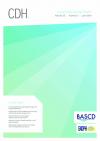Community Dental Health

- Cover Date:
- June 2018
- Print ISSN:
- 0265 539X
- Electronic ISSN:
- 2515-1746
- Vol:
- 35
- Issue:
- 2
Use and misuse of mixed methods in population oral health research: A scoping review
doi:10.1922/CDH_4250Gupta10
Background: Despite the known benefits of a mixed methods approach in health research, little is known of its use in the field of population oral health. Objective: To map the extent of literature using a mixed methods approach to examine population oral health outcomes. Methods: For a comprehensive search of all the available literature published in the English language, databases including PubMed, Dentistry and Oral Sciences Source (DOSS), CINAHL, Web of Science and EMBASE (including Medline) were searched using a range of keywords from inception to October 2017. Only peer-reviewed, population-based studies of oral health outcomes conducted among non-institutionalised participants and using mixed methods were considered eligible for inclusion. Results: Only nine studies met the inclusion criteria and were included in the review. The most frequent oral health outcome investigated was caries experience. However, most studies lacked a theoretical rationale or framework for using mixed methods, or supporting the use of qualitative data. Concurrent triangulation with a convergent design was the most commonly used mixed methods typology for integrating quantitative and qualitative data. The tools used to collect quantitative and qualitative data were mostly limited to surveys and interviews. Conclusion: With growing complexity recognised in the determinants of oral disease, future studies addressing population oral health outcomes are likely to benefit from the use of mixed methods. Explicit consideration of theoretical framework and methodology will strengthen those investigations.
Key words: population oral health, mixed methods research, mixed methodology, scoping review
- Article Price
- £15.00
- Institution Article Price
- £
- Page Start
- 109
- Page End
- 118
- Authors
- Gupta, A., Keuskamp, D.
Articles from this issue
- Title
- Pg. Start
- Pg. End
- Readying community water fluoridation advocates through training, surveillance, and empowerment
- 67
- 70
- Challenges associated with implementation of a school-based tooth-brushing and fluoride varnish programme in a diverse and transient urban population
- 71
- 74
- Community-based nutrition intervention to promote oral health and restore healthy body weight in refugee children: A scoping review
- 81
- 88
- Child, caregiver, and family factors associated with child dental utilization among Mexican migrant families in California
- 89
- 94
- Chronic Intra Oral Pain and Depressive Symptoms in Japanese Community-Dwelling Elderly: A Longitudinal Study
- 102
- 108
- Adaptation and validation of a Nepali version of the Child-Oral Impacts on Daily Performances Index (C-OIDP)
- 119
- 126
